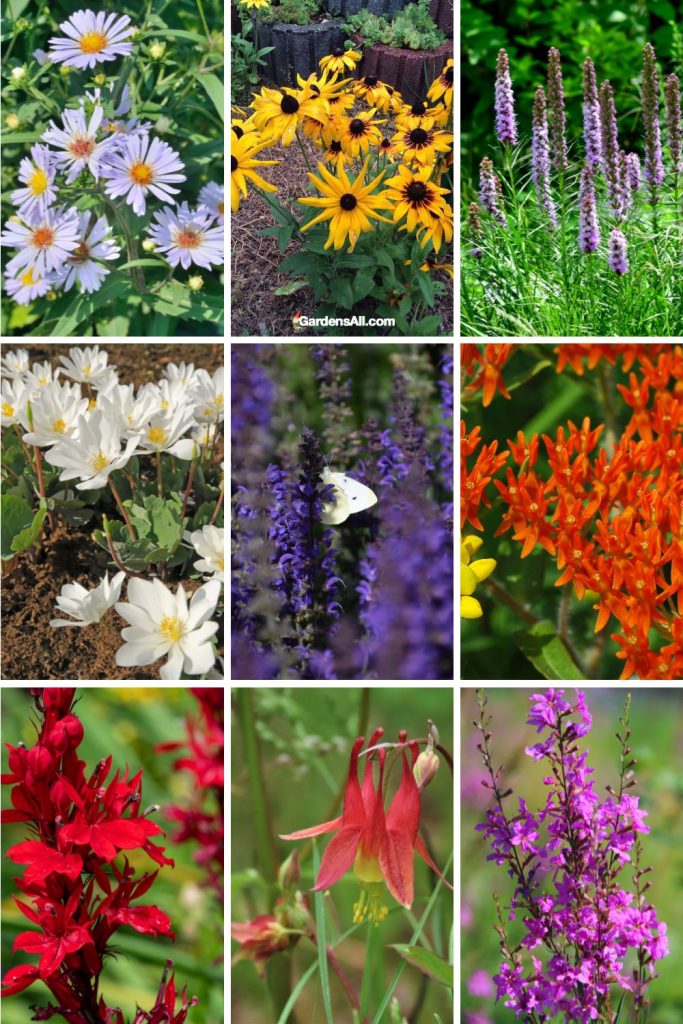We discovered the concept of Keystone Plants thanks to a comment by a member of the GardensAll community when we shared our article on Goldenrod Benefits.
She responded, saying:
“I leave it [my goldenrod] for wildlife seeing as it’s a keystone species.”
~Kristin Sanchez
While we’re familiar with the benefits of native plants, we weren’t familiar with the “keystone species” or “keystone plants” term, so we were glad to dive into the research to learn.
What is a Keystone Plant?
Keystone plants are are critical components of their respective ecosystems, playing a disproportionately significant role in helping to maintain ecological balance and diversity. These plants serve as the backbone of their habitats, offering essential resources like food and shelter to various animal species.
Beyond that, keystone plants often have broader ecological functions such as soil stabilization, water purification, and climate regulation. Their presence or absence can dramatically influence the structure and function of an ecosystem, affecting other plants and animals in a ripple effect. Just as an arch’s keystone holds the structure together, keystone plants are fundamental in sustaining the ecological web.
A keystone plant is a plant species that plays an especially vital role in maintaining the ecological balance and diversity of its habitat.
Characteristics of Keystone Species
- Disproportionate Effect: They have a more significant influence on the community structure than their relative abundance would suggest.
- Niche Occupancy: Keystone species often occupy a unique niche, making them irreplaceable in the ecosystem.
- Community Impact: Removal of the keystone species would result in drastic changes in the ecosystem, often leading to lower biodiversity.
Just as an arch’s keystone holds the structure together, keystone plants are fundamental in sustaining the ecological web.
Overview of 15 Keystone Plants of North America
Below is a partial list of keystone plants found in North America, spanning various types of ecosystems from forests to wetlands. This is just to give you a broad overview of examples. At the end, you’ll see where and how to discover the keystone plants for your specific area.
Forests and Trees
- Aspen (Populus tremuloides)
- Role: Supports a variety of wildlife and helps to prevent soil erosion.
- Hemlock (Tsuga spp.)
- Role: Provides unique habitat and microclimate for various species.
- White Oak (Quercus alba)
- Role: Provides food and shelter to numerous species; its acorns are a critical food source.
See also, Edible Tree Leaves.

Grasslands and Prairies
- Big Bluestem (Andropogon gerardii)
- Role: Dominant grass in tallgrass prairies, provides cover and food for many animals.
- Buffalo Grass (Buchloe dactyloides)
- Role: Tolerant of drought and grazing, important for soil retention.

Wetlands
- Cattail (Typha spp.)
- Role: Provides habitat and food for a variety of species, including humans!
See also Foraging and Eating Cattails
- Role: Provides habitat and food for a variety of species, including humans!
- Spartina Grass (Spartina spp.)
- Role: Critical for salt marsh health and acts as a nursery for various marine species.

Deserts
- Joshua Tree (Yucca brevifolia)
- Role: Provides habitat and food for a variety of desert species.
- Saguaro Cactus (Carnegiea gigantea)
- Role: Acts as a water storage unit and provides food and shelter to desert wildlife.
See also, desert garden ideas.
- Role: Acts as a water storage unit and provides food and shelter to desert wildlife.

Rivers and Lakes
- Willow (Salix spp.)
- Role: Provides habitat and stabilizes riverbanks, essential for various aquatic species.
- Eelgrass (Zostera marina)
- Role: Provides habitat and stabilizes sediment in freshwater systems.

Coastal Ecosystems
- Mangroves (Rhizophora spp.)
- Role: Vital for coastal erosion control and as a habitat for numerous marine species.
Alpine and Tundra
- Whitebark Pine (Pinus albicaulis)
- Role: Provides food and cover at high elevations, helps with soil retention.
Various Ecosystems
- Wildflowers (Various Species)
- Role: Attract pollinators and provide food for herbivores.
- Ferns (Various Species)
- Role: Important for soil health and as ground cover.
This list aims to capture a broad range of keystone plants across North America, each with its own unique impact on local ecosystems. Note that many of these plants serve as both food and habitat for a variety of creatures, making them indispensable for biodiversity and ecosystem health.
Keystone Wildflowers
Wildflowers serve as keystones in many ecosystems, primarily because they attract pollinators, provide food for herbivores, and contribute to soil fertility. Below is a list of keystone wildflowers, categorized by the regions they are commonly found in.
22 North American Keystone Wildflowers
- Aster (Symphyotrichum spp.)
- Role: Late-season nectar and pollen source for a variety of pollinators.
See also: Daisy Fleabane and Calico Aster
- Role: Late-season nectar and pollen source for a variety of pollinators.
- Black-Eyed Susan (Rudbeckia hirta)
- Role: Attracts a wide range of pollinators and provides seeds for birds.
See also: Black Eyed Susan Medicinal Uses
- Role: Attracts a wide range of pollinators and provides seeds for birds.
- Blazing Star (Liatris spicata)
- Role: Provides nectar for butterflies and bees; seeds are consumed by birds.
- Bloodroot (Sanguinaria canadensis)
- Role: Early bloomer providing early nectar source for pollinators.
- Blue Vervain (Verbena hastata)
- Role: Attracts butterflies and other pollinators.
- Butterfly Weed (Asclepias tuberosa)
- Role: Like other milkweeds, serves as a host plant for the monarch butterfly.
- Cardinal Flower (Lobelia cardinalis)
- Role: Attracts hummingbirds, making it important for their migration.
See also: Rain Gardens Direct and Conserve Rainwater
- Role: Attracts hummingbirds, making it important for their migration.
- Columbine (Aquilegia canadensis)
- Role: Attracts hummingbirds and long-tongued insects for specialized pollination.
See also: North Carolina Native Flowers
- Role: Attracts hummingbirds and long-tongued insects for specialized pollination.
- Clover (Trifolium spp.)
- Role: Nitrogen-fixing, improves soil fertility, and serves as forage for various animals.
See also: Benefits of Cover Crops
- Role: Nitrogen-fixing, improves soil fertility, and serves as forage for various animals.
- Dandelion (Taraxacum officinale)
- Role: Early spring food for pollinators and source of medicinal nutrients for humans.
- Fireweed (Chamaenerion angustifolium)
- Role: Colonizes disturbed areas and provides nectar for a range of pollinators.
- Goldenrod (Solidago spp.)
- Role: Late-season pollen source for bees and host for beneficial insects.[1]https://www.bloomingboulevards.org/amp/spotlight-on-keystone-native-plant-species-the-goldenrod?fbclid=IwAR1ODyOJVzYEqB7LvSQAMtUv6aJpGVVFMBg-ceZi753R_-wjZDWjH5-sxrg
See also: Goldenrod Benefits and Uses
- Role: Late-season pollen source for bees and host for beneficial insects.[1]https://www.bloomingboulevards.org/amp/spotlight-on-keystone-native-plant-species-the-goldenrod?fbclid=IwAR1ODyOJVzYEqB7LvSQAMtUv6aJpGVVFMBg-ceZi753R_-wjZDWjH5-sxrg
- Indian Blanket (Gaillardia pulchella)
- Role: Provides nectar for pollinators and seeds for birds.
See also: Florida Drought Tolerant Plants
- Role: Provides nectar for pollinators and seeds for birds.
- Ironweed (Vernonia spp.)
- Role: Provides late summer nectar to a variety of insects and seeds for birds in the fall.
- Joe-Pye Weed (Eutrochium purpureum)
- Role: Attracts a variety of pollinators and acts as a larval host for some butterflies.
- Milkweed (Asclepias spp.)
- Role: Sole food source for monarch butterfly larvae and attracts various pollinators.
See also: Monarch Butterflies and Milkweed
- Role: Sole food source for monarch butterfly larvae and attracts various pollinators.
- Penstemon (Penstemon spp.)
- Role: Attracts hummingbirds and bees, aiding in cross-pollination.
- Purple Coneflower (Echinacea purpurea)
- Role: Attracts pollinators and provides seeds for birds.
See also: Benefits of Echinacea
- Role: Attracts pollinators and provides seeds for birds.
- Trillium (Trillium spp.)
- Role: Early spring nectar source and important for forest floor ecology.
See also: White Trillium and Sweet Betsy Trillium
- Role: Early spring nectar source and important for forest floor ecology.
- Wild Bergamot (Monarda fistulosa)
- Role: Attracts bees, butterflies, and hummingbirds.
- Wild Lupine (Lupinus perennis)
- Role: Attracts bees for pollination and provides habitat for the endangered Karner blue butterfly.
See also: Tall Perennials With Purple Flowers
- Role: Attracts bees for pollination and provides habitat for the endangered Karner blue butterfly.
- Virginia Bluebell (Mertensia virginica)
- Role: Early spring nectar source, attracting a variety of pollinators, including bumblebees and butterflies. Also plays a role in woodland soil health.
See also: Popular Flowers to Plant in Spring
- Role: Early spring nectar source, attracting a variety of pollinators, including bumblebees and butterflies. Also plays a role in woodland soil health.
This starter list should provide a good overview of the key wildflowers in North America that play a vital role as keystone species. Each of these wildflowers contributes to the health and diversity of its respective ecosystem in unique ways.


A Few Keystone Wildflowers from Around the World
Asian Keystone Wildflowers
- Chrysanthemum (Chrysanthemum spp.)
- Role: Provides nectar and pollen for various pollinators.
- Marigold (Tagetes spp.)
- Role: Attracts pollinators and acts as a pest deterrent.
Australian Keystone Wildflowers
- Billy Buttons (Craspedia spp.)
- Role: Attracts pollinators and provides seeds for ground-feeding birds.
- Kangaroo Paw (Anigozanthos spp.)
- Role: Specialized shape attracts specific pollinators, aiding in specialized pollination.
European Keystone Wildflowers
- Cornflower (Centaurea cyanus)
- Role: Attracts pollinators and offers seeds for birds.
- Common Poppy (Papaver rhoeas)
- Role: Provides pollen for bees and is part of the natural regeneration of farmland soils.
- Oxeye Daisy (Leucanthemum vulgare)
- Role: Attracts various pollinators and provides seeds for small mammals.
South American Keystone Wildflowers
- Brazilian Verbena (Verbena brasiliensis)
- Role: Attracts butterflies and hummingbirds.
- Cosmos (Cosmos spp.)
- Role: Attracts a variety of pollinators and provides seeds for birds.
These are just a few examples, and each country and region will have its own set of keystone wildflowers that play a vital role in maintaining the health and balance of local ecosystems.
These wildflowers not only add aesthetic beauty to landscapes but also serve crucial ecological roles. They help maintain biodiversity, improve soil quality, and ensure the survival of various pollinators, making them true keystones in North American ecosystems.
Keystone plants also contribute significantly to biodynamic gardening and permaculture. You may enjoy this permaculture documentary on ‘The Biggest Little Farm’ where you’ll witness one small family’s journey from city life to a successful small farm.
Keystone Plants by Zip Code
The National Wildlife Federation provides a fantastic tool for finding the keystone plants by zip code. This is a super useful resource to bookmark for reference, or to create your list to save and work from towards adding more keystone plants to your yard and garden.
The good news is that there are MANY MORE keystone plants of all kinds than we’ve listed here, that you will find through this native keystone plant by zip code tool.

I’m LeAura Alderson, a garden, herb and plant enthusiast with a passion for discovering the many edible and medicinal benefits of the plants all around us, including the weeds! I’m a writer, editor and media publisher for our family of websites.
While I was certified in fitness and life coaching, I am NOT a health practitioner. However, I’m a lifelong health enthusiast, with a keen interest in healthy, organic foods and making home remedies and the content we share is from our own experience and usage as well as that extracted from scientific research so that you can explore further on your own.
Always seek the advice and guidance of your health practitioners first and foremost.
As a family we’re steadily expanding our gardening, experimentation and knowledge around all things gardening, edible landscaping, fresh organic foods and self sustainability with farming in our future. I also own and manage iCreateDaily.com, a site all about transformation through creation, and the power of positivity, optimism and mindset.
References

